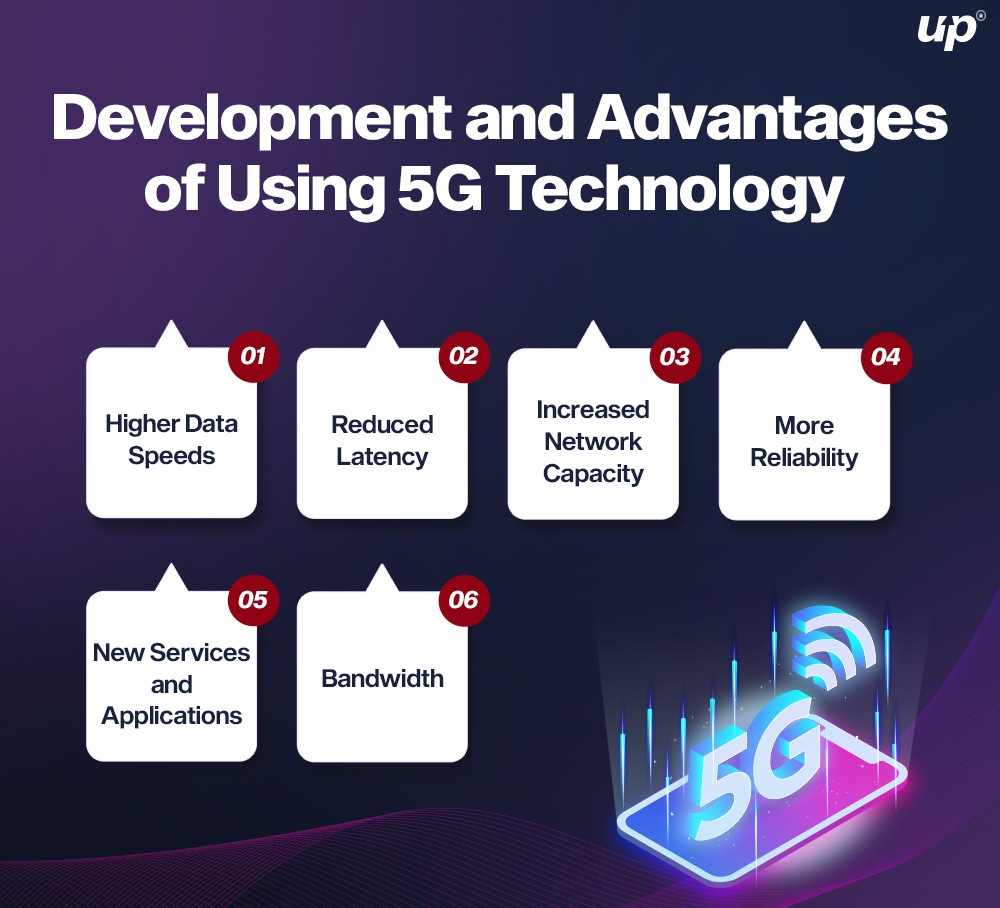Have you ever thought about having the ability to instantly transfer millions of G.B. of data to an unlimited number of devices anywhere in the world? Absolutely, it is now feasible as we have entered the fifth generation of wireless cellular networks, or 5G technology, which is the next era of the technological revolution.
Finally, after much discussion, 5G has entered the market. One of the most significant developments in 5G mobile app development, it is changing various sectors of the economy. But, customers, developers, tech aficionados, and many other people can participate in the excitement.
What is 5G technology?
The fifth generation (5G) of mobile network technology aims to outperform its predecessors in terms of network capacity, latency reduction, and data speed. Modern radio technology and software are used in 5G networks to speed up and improve device connectivity.
Faster download and upload speeds, lower latency, increased network capacity, and the potential to connect more devices at once are some of the fundamental characteristics of 5G technology. By enabling new applications and services that were not conceivable with earlier generations of mobile networks, this technology is anticipated to transform a wide range of industries, including healthcare, transportation, manufacturing, and entertainment.
Faster data rates are possible with 5G networks since they operate in a high-frequency spectrum, but this also necessitates the construction of more cell towers closer together. Worldwide 5G network rollout is still ongoing, with some nations already having extensive coverage and others still in the early phases of adoption.
Rise of 5G
The (5G) wireless technology, which promises to deliver faster internet speeds, reduced latency, and larger capacity than earlier wireless technologies, is becoming more widely deployed and adopted.
In comparison to earlier wireless technology generations, 5G networks use higher frequency bands, allowing them to transfer more data more quickly. The expansion of the Internet of Things (IoT), the creation of smart cities, and the development of driverless vehicles all depend on the ability to link a higher number of devices, which is made possible by this enhanced capacity.
Major telecom firms around the world have been investing extensively in modernizing their infrastructure to support the new technology as 5G network development has been ongoing for several years. Although the early rollouts were only in a few cities and areas, 5G coverage is currently becoming more ubiquitous and is anticipated to grow much more in the upcoming years.
In addition to enhancing mobile broadband connectivity, the rise of 5G has the potential to open up new opportunities in industries like healthcare, education, and entertainment. Aside from privacy and security concerns, there are also worries about the possible effects on human health and the environment of the increasing electromagnetic radiation brought on by 5G networks.
What it Means for Mobile App Development?

Mobile app development is significantly impacted by 5G technology since it makes it possible to create more sophisticated and cutting-edge programmed that can take use of the faster speeds and reduced latency provided by 5G networks. The following are some potential effects of 5G technology on the app Development:
Faster app performance: Performance of mobile apps is now faster than ever thanks to 5G technology. Because of this, programmers can make more intricate programmer that yet respond to user input and offer a smooth user experience.
Real-time interactivity: Because of 5G’s low latency, app developers can create services that provide real-time interactivity, including gaming, augmented and virtual reality (AR/VR), and live streaming. Both the user experience and new use cases may be enhanced by this.
Increasing the use of AI and ML in mobile apps: 5G’s high network capacity and low latency can enable more sophisticated use cases for AI and ML in mobile apps. Developers can design more intricate algorithms that analyze data more quickly and effectively.
What Does the Growth of 5G Technology Mean for the Development of Mobile Apps?
5G technology promises to be a game-changer for 5G mobile app development. The fifth generation of mobile network technology offers greater bandwidth, lower latency, and faster speeds than its forerunners. As a result, apps can be created to make use of these functionalities and provide new and improved services.
Comparing emerging 5G networks to 4G, they offer less latency, more capacity, and more bandwidth. The way people live, work, and play around the world will be significantly impacted by these network enhancements. Comparing emerging 5G networks to 4G, they offer less latency, more capacity, and more bandwidth.
The 5G in Mobile App Development will be impacted in the following ways by the rise of 5G technology:
Faster data transmission rates: Up to 100 times faster data transfer rates than 4G are promised by 5G. Because of this, material may load in apps significantly more quickly, improving the user experience. On 5G networks, developers may make more intricate apps that load quickly and have high-resolution images and animations.
Less lag time between the user’s activity and the app’s response: 5G technology promises to have lower latency than 4G. This creates new opportunities for real-time applications like video conferencing tools, internet gaming, and virtual and augmented reality experiences.
More bandwidth: 5G technology offers more bandwidth, allowing for simultaneous connections from more devices without slowing down the network. The ability to handle more data-intensive tasks like streaming high-definition video, downloading large files, and running many apps simultaneously will allow developers to make apps that can handle these demands.
Internet of Things (IoT): In the future years, the use of Internet of Things (IoT) devices is anticipated to increase significantly, and the development of 5G will make this possible. In order to give real-time data and insights, developers can construct apps that link to these devices and make use of 5G technology. The Internet of Things (IoT) can be more thoroughly integrated into mobile apps because to the expanded network capacity and ability to connect more devices at once. Businesses may have new chances to gather and examine data from linked devices as a result of this.
Improved location-based services: 5G technology makes it possible to track your location with more accuracy, allowing apps to provide more precise and individualized location-based services. To give consumers a more immersive and interactive experience based on their specific location, developers can make apps that use augmented reality.
In conclusion, the advent of 5G technology will transform the Mobile App Development by enabling programmers to produce more intricate and cutting-edge applications with quicker speeds, reduced latency, and greater capacity. Also, it will make it possible for IoT devices to be used widely and deliver location-based services that are more precise and customized.
Development and Advantages of using 5G Technology-

Following are some Development and advantages of using 5G technology:
Higher Data Speeds: Compared to earlier generations of mobile networks, 5G technology is anticipated to offer substantially faster data rates. Large files may be downloaded and uploaded in a matter of seconds thanks to 5G networks, which are predicted to offer data speeds up to 100 times faster than 4G networks.
Reduced Latency: Compared to earlier generations of mobile networks, 5G technology promises much lower latency. This results in minimal transmission delay, which is crucial for real-time applications like online gaming, augmented and virtual reality, and remote surgery.
Increased Network Capacity: Compared to earlier mobile network generations, 5G technology can connect more devices at once. This is crucial for the Internet of Things (IoT), which depends on many connected devices to function.
More Reliability: 5G technology is intended to have greater reliability than earlier mobile network generations. In order to increase signal strength and decrease interference, it makes use of cutting-edge technology like massive MIMO and beamforming.
New Services and Applications: Previous generations of mobile networks were unable to support new apps and services due to their slower data speeds, higher latency, and reduced network capacity. For instance, 5G can support applications including autonomous vehicles, smart cities, and remote surgery.
Bandwidth: Increased bandwidth makes it possible for data to be transferred seamlessly, enhancing device connectivity and the user experience as a whole. Also, the technology improves performance by allowing users to switch between cellular devices and wireless wifi devices seamlessly. Another benefit of 5G technology is this. Moreover, consumers’ bandwidth would increase if there were fewer 5G towers.
What has changed in the world of cellular technologies?
To fully comprehend the effect and benefits of 5G, we must first comprehend its predecessor. This is a brief overview of its cellular technologies:
1G (Analog)
It was introduced to the market in 1980 and represents the first generation of wireless communication. With a data transfer speed of 2.4 kbps, people will use this to make basic phone calls.
2G (GPRS)
The first-ever digital cellular network, the 2G, was introduced in 1991, ten years after the 1G. Users can connect to the internet, send and receive text messages (SMS), and make phone conversations at a 50kbps speed.
3G (UMTS)
With a speed of 2 Mbps, the third generation of telecommunications technology was introduced in 1998, ushering in the first smartphone revolution as users were able to transfer images and conduct video calls.
4G (LTE)
Live video streaming, gaming, and other data-intensive activities are all possible with the latest wireless technology standard, 4G, which was released to the market in 2008. It has a 100Mbps maximum speed.
How does 5G Technology operate?
Compared to earlier generations of mobile networks, 5G technology offers higher data rates, reduced latency, and larger network capacity. It does this by combining cutting-edge hardware and software technologies. This is how it goes:
Modern antennas
To increase signal strength and decrease interference, 5G technology uses upgraded antennas known as massive MIMO (Multiple Input Multiple Output) and beamforming. These antennas can focus signals on certain hardware, boosting transmission rates and cutting latency.
High-frequency radio waves
The millimetre wave (mmWave) spectrum of high-frequency radio waves is used by 5G technology to deliver data. While having a smaller range than radio waves with lower frequencies, these radio waves may transport more data and offer quicker transmission speeds.
Network slicing
Network slicing is a method used by 5G technology to build virtual networks that are tailored for particular services or applications. This makes it possible for 5G networks to handle a variety of use cases, from low-latency applications like remote surgery to high-bandwidth ones like video streaming.
Cloud-based architecture
Cloud-based infrastructure is necessary for 5G technologies to process and store data. This makes 5G networks more adaptable and scalable than earlier mobile network generations.
Improved device connectivity
The Internet of Things is perfect for 5G technology since it can support many connected devices at once (IoT). New use cases, including connected cars and smart homes, may be made possible by this.
Usually, 5G technology employs a combination of cutting-edge hardware and software technologies to offer higher network capacity, reduced latency, and faster data throughput than earlier generations of mobile networks. As a result, new applications and services may be made possible, stimulating the economy.
FAQs
Why is the future of mobile app development 5G technology?
How people use their 5G in Mobile App Development on them will alter as a result of the 5G network. Ten times the speed of the 4G network, it has a connection speed of 10 gigabits per second. More options will be available to mobile app developers on this 5G network, speeding up data sending and receiving.
How does artificial intelligence benefit from 5G?
It enhances a system that forms your firm, such the supply chain, automates the procedures, and aids in bettering your understanding of your customers.
What impact does 5G have on communication?
In order to better support your conversion process, 5G will advance communication technology by reducing latency, conserving energy, lowering costs, delivering high data throughput rates, and expanding system capacity.
Conclusion
As the ultimate advancement in wireless communication, 5G was developed. Nonetheless, there are still many things to be perfected, including certain cradles. Although 5G has the fastest network in the world, there is now a lot of doubt about it. For both users and developers, 5G is a blessing.
Hire qualified mobile app developers from a reputable mobile app development business if you want to create next-generation mobile apps that are compatible with the 5G network. Thus, to harness the power of 5G and welcome its revolutionary advantages.










